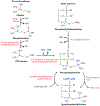Phospholipid Remodeling in Physiology and Disease
- PMID: 30379616
- PMCID: PMC7008953
- DOI: 10.1146/annurev-physiol-020518-114444
Phospholipid Remodeling in Physiology and Disease
Abstract
Phospholipids are major constituents of biological membranes. The fatty acyl chain composition of phospholipids determines the biophysical properties of membranes and thereby affects their impact on biological processes. The composition of fatty acyl chains is also actively regulated through a deacylation and reacylation pathway called Lands' cycle. Recent studies of mouse genetic models have demonstrated that lysophosphatidylcholine acyltransferases (LPCATs), which catalyze the incorporation of fatty acyl chains into the sn-2 site of phosphatidylcholine, play important roles in pathophysiology. Two LPCAT family members, LPCAT1 and LPCAT3, have been particularly well studied. LPCAT1 is crucial for proper lung function due to its role in pulmonary surfactant biosynthesis. LPCAT3 maintains systemic lipid homeostasis by regulating lipid absorption in intestine, lipoprotein secretion, and de novo lipogenesis in liver. Mounting evidence also suggests that changes in LPCAT activity may be potentially involved in pathological conditions, including nonalcoholic fatty liver disease, atherosclerosis, viral infections, and cancer. Pharmacological manipulation of LPCAT activity and membrane phospholipid composition may provide new therapeutic options for these conditions.
Keywords: cholesterol metabolism; intestinal homeostasis; lipid metabolism; lipogenesis; lipoprotein production; lysophosphatidylcholine acyltransferase; phospholipid remodeling; surfactant biosynthesis.
Figures



Similar articles
-
Research progress, challenges and perspectives of phospholipids metabolism in the LXR‑LPCAT3 signaling pathway and its relation to NAFLD (Review).Int J Mol Med. 2024 Apr;53(4):32. doi: 10.3892/ijmm.2024.5356. Epub 2024 Feb 16. Int J Mol Med. 2024. PMID: 38362962 Free PMC article. Review.
-
Substrate preferences of a lysophosphatidylcholine acyltransferase highlight its role in phospholipid remodeling.Lipids. 2008 Oct;43(10):895-902. doi: 10.1007/s11745-008-3233-y. Epub 2008 Sep 10. Lipids. 2008. PMID: 18781350
-
Deficiency in lysophosphatidylcholine acyltransferase 3 reduces plasma levels of lipids by reducing lipid absorption in mice.Gastroenterology. 2015 Nov;149(6):1519-29. doi: 10.1053/j.gastro.2015.07.012. Epub 2015 Jul 27. Gastroenterology. 2015. PMID: 26226572 Free PMC article.
-
Lysophosphatidylcholine acyltransferase 3 knockdown-mediated liver lysophosphatidylcholine accumulation promotes very low density lipoprotein production by enhancing microsomal triglyceride transfer protein expression.J Biol Chem. 2012 Jun 8;287(24):20122-31. doi: 10.1074/jbc.M111.334664. Epub 2012 Apr 17. J Biol Chem. 2012. PMID: 22511767 Free PMC article.
-
Recent progress on acyl CoA: lysophospholipid acyltransferase research.J Lipid Res. 2009 Apr;50 Suppl(Suppl):S46-51. doi: 10.1194/jlr.R800035-JLR200. Epub 2008 Oct 17. J Lipid Res. 2009. PMID: 18931347 Free PMC article. Review.
Cited by
-
Fatty Acids and Membrane Lipidomics in Oncology: A Cross-Road of Nutritional, Signaling and Metabolic Pathways.Metabolites. 2020 Aug 25;10(9):345. doi: 10.3390/metabo10090345. Metabolites. 2020. PMID: 32854444 Free PMC article. Review.
-
Differential effect of an evolving amyloid and tau pathology on brain phospholipids and bioactive lipid mediators in rat models of Alzheimer-like pathology.J Neuroinflammation. 2024 Jul 30;21(1):185. doi: 10.1186/s12974-024-03184-7. J Neuroinflammation. 2024. PMID: 39080670 Free PMC article.
-
Deferoxamine Alleviates Osteoarthritis by Inhibiting Chondrocyte Ferroptosis and Activating the Nrf2 Pathway.Front Pharmacol. 2022 Mar 14;13:791376. doi: 10.3389/fphar.2022.791376. eCollection 2022. Front Pharmacol. 2022. PMID: 35359876 Free PMC article.
-
Critical Review on Fatty Acid-Based Food and Nutraceuticals as Supporting Therapy in Cancer.Int J Mol Sci. 2022 May 27;23(11):6030. doi: 10.3390/ijms23116030. Int J Mol Sci. 2022. PMID: 35682708 Free PMC article. Review.
-
Lysophospholipids Are Associated With Outcomes in Hospitalized Patients With Mild Traumatic Brain Injury.J Neurotrauma. 2024 Jan;41(1-2):59-72. doi: 10.1089/neu.2023.0046. Epub 2023 Oct 20. J Neurotrauma. 2024. PMID: 37551969 Free PMC article.
References
-
- Spector AA, Yorek MA. 1985. Membrane lipid composition and cellular function. J. Lipid Res 26:1015–35 - PubMed
-
- Wymann MP, Schneiter R. 2008. Lipid signalling in disease. Nat. Rev. Mol. Cell Biol 9:162–76 - PubMed
-
- Harayama T, Riezman H. 2018. Understanding the diversity of membrane lipid composition. Nat. Rev. Mol. Cell Biol 19:281–96 - PubMed
-
- Lands WE. 1958. Metabolism of glycerolipides: a comparison of lecithin and triglyceride synthesis. J. Biol. Chem 231:883–88 - PubMed
Publication types
MeSH terms
Substances
Grants and funding
LinkOut - more resources
Full Text Sources

